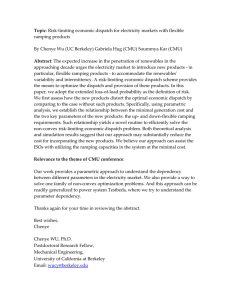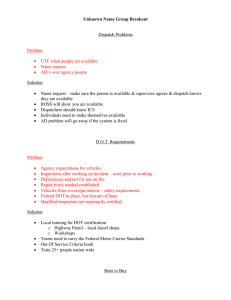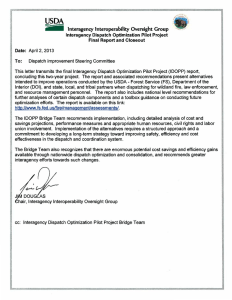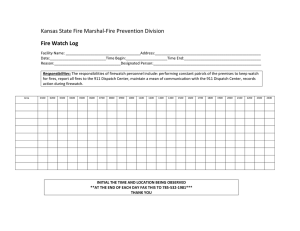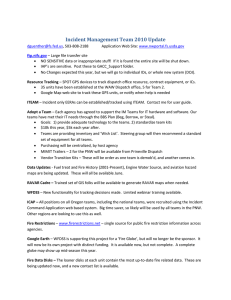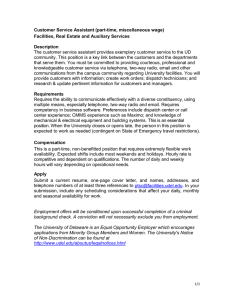Manage implementation of power system dispatch instructions
advertisement
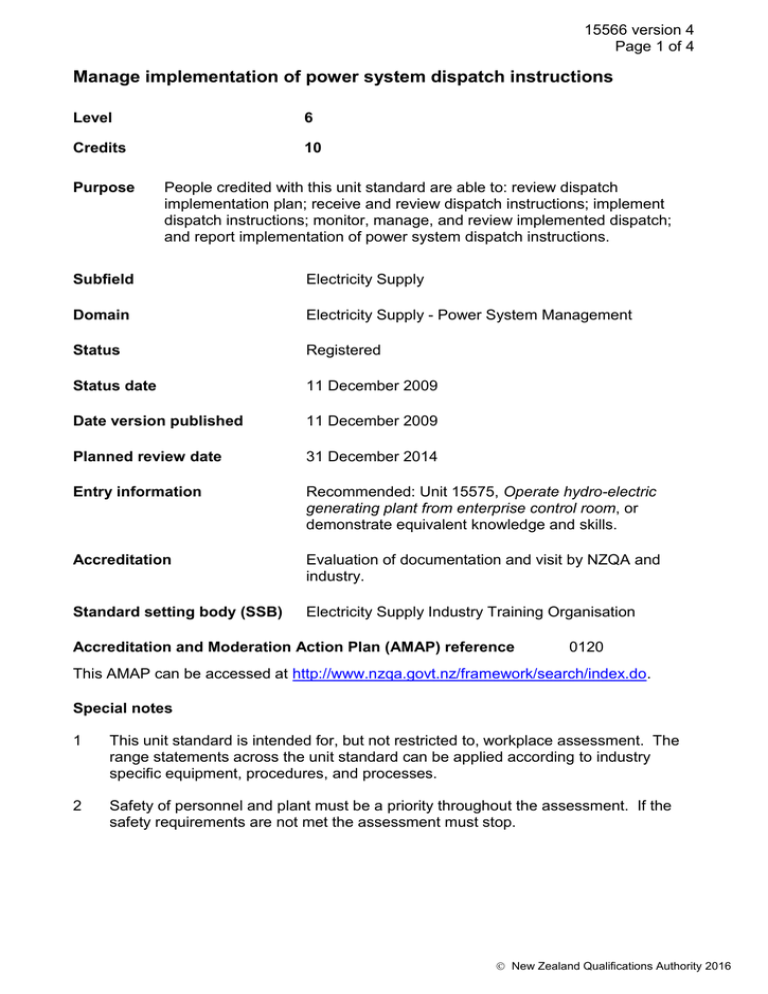
15566 version 4 Page 1 of 4 Manage implementation of power system dispatch instructions Level 6 Credits 10 Purpose People credited with this unit standard are able to: review dispatch implementation plan; receive and review dispatch instructions; implement dispatch instructions; monitor, manage, and review implemented dispatch; and report implementation of power system dispatch instructions. Subfield Electricity Supply Domain Electricity Supply - Power System Management Status Registered Status date 11 December 2009 Date version published 11 December 2009 Planned review date 31 December 2014 Entry information Recommended: Unit 15575, Operate hydro-electric generating plant from enterprise control room, or demonstrate equivalent knowledge and skills. Accreditation Evaluation of documentation and visit by NZQA and industry. Standard setting body (SSB) Electricity Supply Industry Training Organisation Accreditation and Moderation Action Plan (AMAP) reference 0120 This AMAP can be accessed at http://www.nzqa.govt.nz/framework/search/index.do. Special notes 1 This unit standard is intended for, but not restricted to, workplace assessment. The range statements across the unit standard can be applied according to industry specific equipment, procedures, and processes. 2 Safety of personnel and plant must be a priority throughout the assessment. If the safety requirements are not met the assessment must stop. New Zealand Qualifications Authority 2016 15566 version 4 Page 2 of 4 3 Performance and work practices in relation to the elements and performance criteria must comply with all current legislation, especially the Electricity Act 1992, and any regulations and codes of practice recognised under that statute; the Health and Safety in Employment Act 1992; the Electricity Governance Regulations and Rules (EGRs); and the Resource Management Act 1991. Electricity supply industry codes of practice and documented industry procedures include the Safety Manual – Electricity Industry (SM-EI) (2004) Wellington: Electricity Engineers’ Association. A full list of current legislation and industry codes is available from the Electricity Supply Industry Training Organisation, PO Box 1245, Waikato Mail Centre, Hamilton 3240. 4 The phrase in accordance with industry requirements is implicit in all elements and performance criteria in this unit standard. 5 Industry requirements include all asset owner requirements; manufacturers’ specifications; and enterprise requirements which cover the documented workplace policies, procedures, specifications, and business and quality management requirements relevant to the workplace in which assessment is carried out. 6 Practical workplace exercises or simulations should be used for training and assessment where possible. 7 Dispatch implementation plan refers to the internal plan produced by an enterprise for the dispatch of electricity generation. Elements and performance criteria Element 1 Review dispatch implementation plan. Range may include but is not limited to – generation implementation plan. Performance criteria 1.1 Review of plan ensures generation distribution meets both short and long term enterprise requirements. Range 1.2 may include but is not limited to – active power, reactive power, spinning reserve, plant availability, transmission and plant constraints, consents, contracts. Review of plan ensures fuel management meets both short and long term enterprise requirements. Range may include but is not limited to – hydrology, steam, gas, coal, oil, diesel, wind. New Zealand Qualifications Authority 2016 15566 version 4 Page 3 of 4 Element 2 Receive and review dispatch instructions. Range may include but is not limited to – active power, reactive power, voltage, frequency, frequency band, time error correction, reserve. Performance criteria 2.1 Dispatch instructions are receipted. Range 2.2 may include but is not limited to – electronic, voice, paper, log. Dispatch instructions are assessed against New Zealand wholesale electricity market enterprise offers. Range may include but is not limited to – offer profiles – energy, reserve, frequency keeping. 2.3 Dispatch instructions are either accepted or queried with the dispatcher. 2.4 Dispatch instructions issued under emergency situations are accepted. Range may include but is not limited to – grid emergency, system security situation, consents. Element 3 Implement dispatch instructions. Performance criteria 3.1 Dispatch instructions are implemented. 3.2 Electrical energy generation is allocated to generating stations and/or generators. 3.3 Spinning reserve is allocated to generating stations and/or generators. 3.4 Voltage support is allocated to generating stations and/or generators. 3.5 Frequency control and frequency keeping band is allocated to generating stations and/or generators in accordance with dispatch instruction. 3.6 Generating plant status is changed. New Zealand Qualifications Authority 2016 15566 version 4 Page 4 of 4 Element 4 Monitor, manage, and review implemented dispatch. Performance criteria 4.1 Implemented dispatch is monitored to ensure dispatch requirements are met. 4.2 Changes from plan are identified and corrective actions initiated. Range may include but is not limited to – New Zealand wholesale electricity market enterprise offers, pre Dispatch Schedule (PDS), offer, generation implementation plan. Element 5 Report implementation of power system dispatch instructions. Performance criteria 5.1 Reported information is completed and actioned. 5.2 Dispatch instruction information is recorded in the required format and filed within scheduled timeframe. Please note Providers must be accredited by NZQA, or an inter-institutional body with delegated authority for quality assurance, before they can report credits from assessment against unit standards or deliver courses of study leading to that assessment. Industry Training Organisations must be accredited by NZQA before they can register credits from assessment against unit standards. Accredited providers and Industry Training Organisations assessing against unit standards must engage with the moderation system that applies to those standards. Accreditation requirements and an outline of the moderation system that applies to this standard are outlined in the Accreditation and Moderation Action Plan (AMAP). The AMAP also includes useful information about special requirements for organisations wishing to develop education and training programmes, such as minimum qualifications for tutors and assessors, and special resource requirements. Comments on this unit standard Please contact the Electricity Supply Industry Training Organisation info@esito.org.nz if you wish to suggest changes to the content of this unit standard. New Zealand Qualifications Authority 2016
